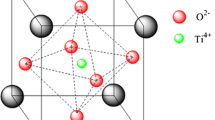Abstract
Perovskite types (1 − x)[PMN–PT(65/35)]–xPZ (with x = 0, 0.1, 0.3, 0.5, 0.7 and 0.9) piezoelectric ceramics were prepared by a modified columbite precursor method. The lattice parameters of the (1 − x)[PMN–PT(65/35)]–xPZ ceramics increase with the addition of larger Zr4+ ion compared to that of other B-site ions. The SEM photographs of all the samples with different PZ content exhibit homogeneous and dense microstructure. The P–E loops indicate the PMN–PT–PZ ternary system has excellent ferroelectric properties. Both d33 and kp dependences in PZ content show similar variation. Introduction of a small amount of PZ content in the PMN–PT(65/35) ceramics enhanced the relaxor behavior, which was confirmed by studying frequency and temperature-dependent dielectric behavior. The increasing values of diffuseness parameter obtained from the fit of a modified Curie–Weiss law established the relaxor nature.








Similar content being viewed by others
References
Service RE (1997) Science 275:1878
Park S-E, Shrout TR (1997) J Appl Phys 82:1804
Park S-E, Shrout TR (1997) Mater Res Innov 1:20
Nomura S, Uchino K (1983) Ferroelectrics 50:197
Masuzawa H, Ito Y, Nakaya C, Takeuchi H, Jyomura S (1989) Jpn J Appl Phys 28:101
Yamashita Y, Hosono Y, Harada K, Yasuda N (2002) IEEE Trans Ultrason Ferroelectr Freq Control 49:184
Ari-gur P, Benguigui L (1975) J Phys D Appl Phys 8:1856
Hu XB, Wang JY, Ma LL, Xu XG, Luo HS, Zhu PP, Tian YL, Cryst J (2005) Growth 275:e1703
Harmer MP, Chen J, Peng P, Chan HM, Smyth DM (1989) Ferroelectrics 97:263
Chen J, Chan HM, Harmer MH (1989) J Am Ceram Soc 72:593
Jiang XP, Fang JW, Zeng HR, Chu BJ, Li GR, Chen DR, Yin QR (2000) Mater Lett 44:219
Xia ZG, Li Q (2007) J Phys D Appl Phys 40:7826
Xia ZG, Wang L, Yan WX, Li Q, Zhang L (2007) Mater Res Bull 42:1715
Swartz SL, Shrout TR (1982) Mater Res Bull 17:1245
Wang L, Li Q, Xue LH, Zhang YL (2007) J Phys Chem Solids 68:2008
Randall CA, Kim N, Kucera J, Cao W, Shrout TR (1998) J Am Ceram Soc 81:677
Yoon KH, Lee HR (2001) J Appl Phys 89:3915
Yimniruna R, Ananta S, Laoratanakul P (2005) J Eur Ceram 25:3235
Uchino K, Nomura S (1982) Ferroelectr Lett 44:55
Author information
Authors and Affiliations
Corresponding author
Rights and permissions
About this article
Cite this article
Wang, L., Li, Q., Xia, Z. et al. Compositional dependence of structural and electrical properties in (1 − x)[PMN–PT(65/35)]–xPZ solid solutions. J Mater Sci 44, 244–249 (2009). https://doi.org/10.1007/s10853-008-3075-2
Received:
Accepted:
Published:
Issue Date:
DOI: https://doi.org/10.1007/s10853-008-3075-2




